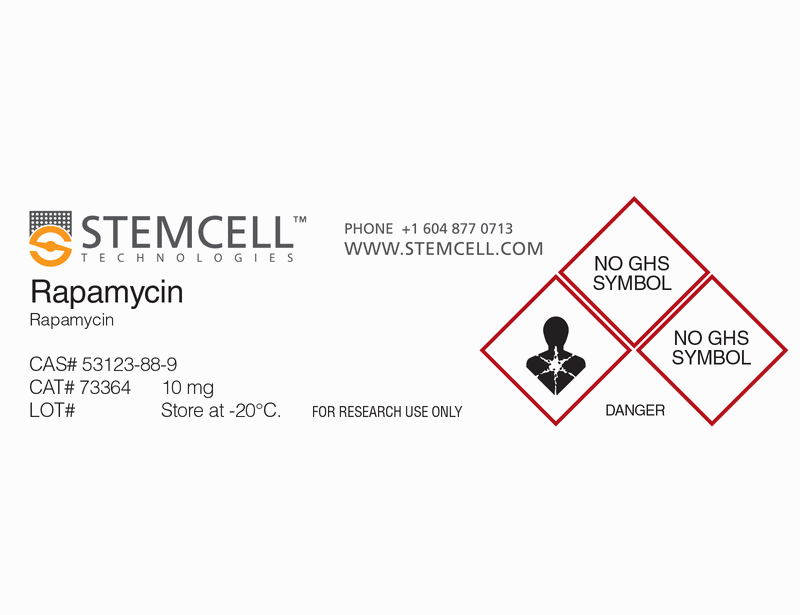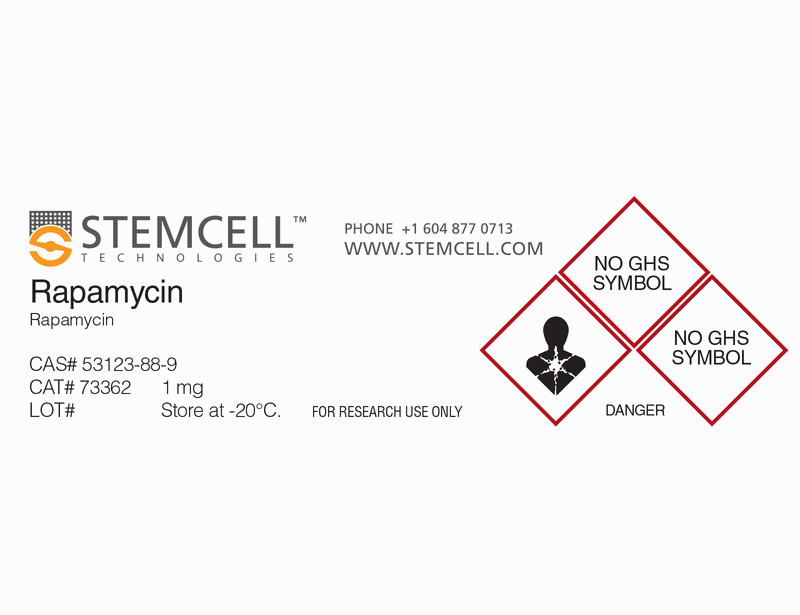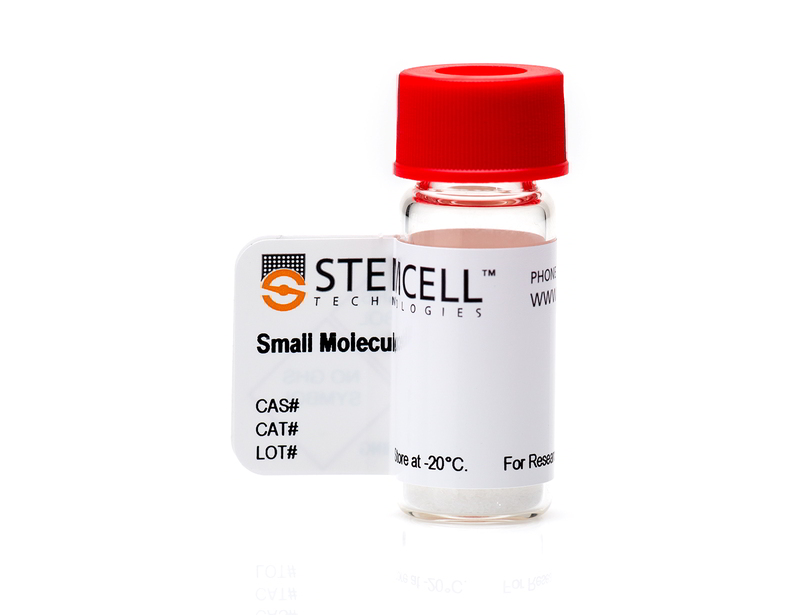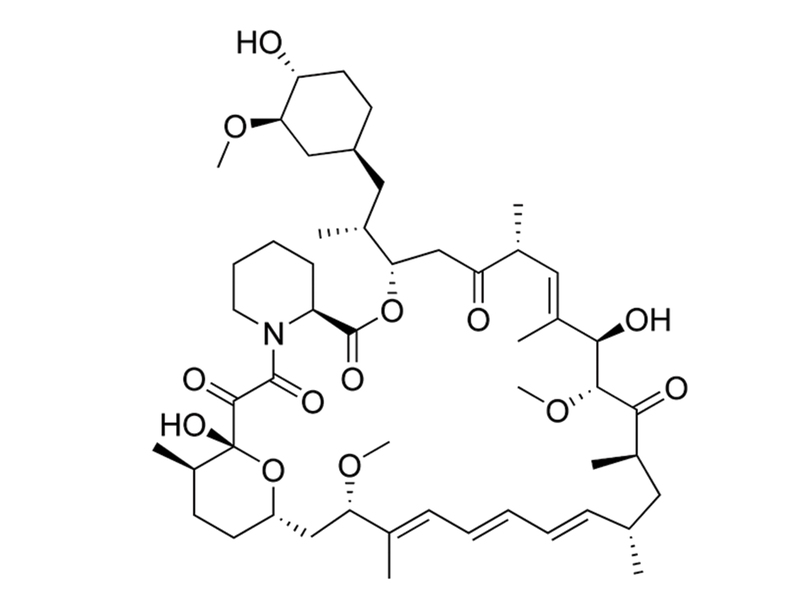Rapamycin
Antibiotic; mTOR pathway inhibitor; Inhibits FKBP-12
概要
Rapamycin is a macrolide antibiotic and immunosuppressive compound that inhibits mammalian target of rapamycin (mTOR) signaling. It acts through formation of a complex with cytosolic FK-binding protein 12 (FKBP-12), which directly binds to mTOR complex 1 (mTORC1). Its immunosuppressive effects are mediated through inhibition of IL-2 signaling that is critical for T-cell proliferation and activation (Gibbons et al.; Kay et al.). Rapamycin shows antifungal activity against Candida albicans and other fungi (Vézina et al.)
CANCER RESEARCH
· Inhibits growth of MDA-MB-468 human breast cancer cells in vitro, and inhibits tumor growth in a mouse xenograft model in vivo (Akcakanat et al.).
· Induces autophagy in malignant glioma cells (Takeuchi et al.).
CANCER RESEARCH
· Inhibits growth of MDA-MB-468 human breast cancer cells in vitro, and inhibits tumor growth in a mouse xenograft model in vivo (Akcakanat et al.).
· Induces autophagy in malignant glioma cells (Takeuchi et al.).
Alternative Names
AY 22989; Cypher; NSC 226080; Sirolimus
Cell Type
Cancer Cells and Cell Lines, Mammary Cells
Species
Human, Mouse, Rat, Non-Human Primate, Other
Application
Antibiotic
Area of Interest
Cancer Research
CAS Number
53123-88-9
Chemical Formula
C₅₁H₇₉NO₁₃
Molecular Weight
914.2 g/mol
Purity
≥ 95%
Pathway
mTOR
Target
FKBP-12
技术资料
| Document Type | 产品名称 | Catalog # | Lot # | 语言 |
|---|---|---|---|---|
| Product Information Sheet | Rapamycin | 73362, 73364 | All | English |
| Safety Data Sheet | Rapamycin | 73362, 73364 | All | English |
数据及文献
Publications (6)
Journal of immunology (Baltimore, Md. : 1950) 2014
Mechanistic target of rapamycin inhibition extends cellular lifespan in dendritic cells by preserving mitochondrial function.
Abstract
Abstract
TLR-mediated activation of dendritic cells (DCs) is associated with a metabolic transition in which mitochondrial oxidative phosphorylation is inhibited by endogenously synthesized NO and the cells become committed to glucose and aerobic glycolysis for survival. We show that inhibition of mechanistic target of rapamycin (mTOR) extends the lifespan of TLR-activated DCs by inhibiting the induction of NO production, thereby allowing the cells to continue to use their mitochondria to generate ATP, and allowing them the flexibility to use fatty acids or glucose as nutrients to fuel core metabolism. These data provide novel mechanistic insights into how mTOR modulates DC metabolism and cellular longevity following TLR activation and provide an explanation for previous findings that mTOR inhibition enhances the efficacy of DCs in autologous vaccination.
Seminars in oncology 2009 DEC
Mammalian target of rapamycin: discovery of rapamycin reveals a signaling pathway important for normal and cancer cell growth.
Abstract
Abstract
Since the discovery of rapamycin, considerable progress has been made in unraveling the details of the mammalian target of rapamycin (mTOR) signaling network, including the upstream mechanisms that modulate mTOR signaling functions, and the roles of mTOR in the regulation of mRNA translation and other cell growth-related responses. mTOR is found in two different complexes within the cell, mTORC1 and mTORC2, but only mTORC1 is sensitive to inhibition by rapamycin. mTORC1 is a master controller of protein synthesis, integrating signals from growth factors within the context of the energy and nutritional conditions of the cell. Activated mTORC1 regulates protein synthesis by directly phosphorylating 4E-binding protein 1 (4E-BP1) and p70S6K (S6K), translation initiation factors that are important to cap-dependent mRNA translation, which increases the level of many proteins that are needed for cell cycle progression, proliferation, angiogenesis, and survival pathways. In normal physiology, the roles of mTOR in both glucose and lipid catabolism underscore the importance of the mTOR pathway in the production of metabolic energy in quantities sufficient to fuel cell growth and mitotic cell division. Several oncogenes and tumor-suppressor genes that activate mTORC1, often through the phosphatidylinositol 3-kinase (PI3K)/AKT pathway, are frequently dysregulated in cancer. Novel analogs of rapamycin (temsirolimus, everolimus, and deforolimus), which have improved pharmaceutical properties, were designed for oncology indications. Clinical trials of these analogs have already validated the importance of mTOR inhibition as a novel treatment strategy for several malignancies. Inhibition of mTOR now represents an attractive anti-tumor target, either alone or in combination with strategies to target other pathways that may overcome resistance. The far-reaching downstream consequences of mTOR inhibition make defining the critical molecular effector mechanisms that mediate the anti-tumor response and associated biomarkers that predict responsiveness to mTOR inhibitors a challenge and priority for the field.
Molecular Cancer 2009
The rapamycin-regulated gene expression signature determines prognosis for breast cancer
Abstract
Abstract
BACKGROUND: Mammalian target of rapamycin (mTOR) is a serine/threonine kinase involved in multiple intracellular signaling pathways promoting tumor growth. mTOR is aberrantly activated in a significant portion of breast cancers and is a promising target for treatment. Rapamycin and its analogues are in clinical trials for breast cancer treatment. Patterns of gene expression (metagenes) may also be used to simulate a biologic process or effects of a drug treatment. In this study, we tested the hypothesis that the gene-expression signature regulated by rapamycin could predict disease outcome for patients with breast cancer. RESULTS: Colony formation and sulforhodamine B (IC50 textless 1 nM) assays, and xenograft animals showed that MDA-MB-468 cells were sensitive to treatment with rapamycin. The comparison of in vitro and in vivo gene expression data identified a signature, termed rapamycin metagene index (RMI), of 31 genes upregulated by rapamycin treatment in vitro as well as in vivo (false discovery rate of 10%). In the Miller dataset, RMI did not correlate with tumor size or lymph node status. High (textgreater75th percentile) RMI was significantly associated with longer survival (P = 0.015). On multivariate analysis, RMI (P = 0.029), tumor size (P = 0.015) and lymph node status (P = 0.001) were prognostic. In van 't Veer study, RMI was not associated with the time to develop distant metastasis (P = 0.41). In the Wang dataset, RMI predicted time to disease relapse (P = 0.009). CONCLUSION: Rapamycin-regulated gene expression signature predicts clinical outcome in breast cancer. This supports the central role of mTOR signaling in breast cancer biology and provides further impetus to pursue mTOR-targeted therapies for breast cancer treatment.
Blood 2007
Rapamycin derivatives reduce mTORC2 signaling and inhibit AKT activation in AML.
Abstract
Abstract
The mTOR complex 2 (mTORC2) containing mTOR and rictor is thought to be rapamycin insensitive and was recently shown to regulate the prosurvival kinase AKT by phosphorylation on Ser473. We investigated the molecular effects of mTOR inhibition by the rapamycin derivatives (RDs) temsirolimus (CCI-779) and everolimus (RAD001) in acute myeloid leukemia (AML) cells. Unexpectedly, RDs not only inhibited the mTOR complex 1 (mTORC1) containing mTOR and raptor with decreased p70S6K, 4EPB1 phosphorylation, and GLUT1 mRNA, but also blocked AKT activation via inhibition of mTORC2 formation. This resulted in suppression of phosphorylation of the direct AKT substrate FKHR and decreased transcription of D-cyclins in AML cells. Similar observations were made in samples from patients with hematologic malignancies who received RDs in clinical studies. Our study provides the first evidence that rapamycin derivatives inhibit AKT signaling in primary AML cells both in vitro and in vivo, and supports the therapeutic potential of mTOR inhibition strategies in leukemias.
Transplantation proceedings 1998
Chemical modification of rapamycin: the discovery of SDZ RAD.
Abstract
Abstract
Immunology 1991
Inhibition of T and B lymphocyte proliferation by rapamycin.
Abstract
Abstract
The immunosuppressive macrolide rapamycin shows marked structural similarity to FK-506, and like FK-506 inhibits the activation of cultured T and B lymphocytes at concentrations as low as 10(-10) M. However, rapamycin blocks T-lymphocyte proliferation at a much later stage than FK-506. It also inhibits human, porcine and murine T- and B-lymphocyte activation by all pathways tested, including pathways which are insensitive to FK-506, such as interleukin-2 (IL-2)-mediated proliferation of IL-2-dependent T-cell lines, activation of human peripheral blood T lymphocytes by phorbol ester and anti-CD28 and activation of murine B lymphocytes by bacterial lipopolysaccharide. Thus these two macrolides that bind competitively to the same major intracellular receptor protein inhibit T- and B-lymphocyte activation by quite distinct mechanisms.




